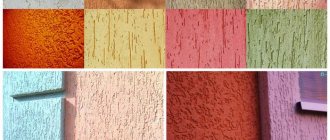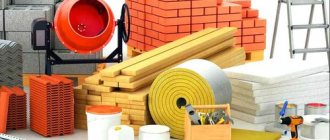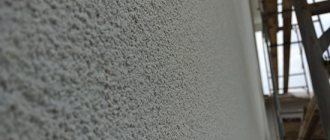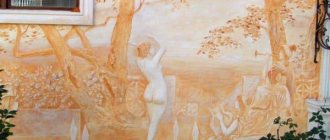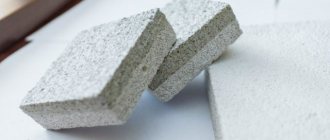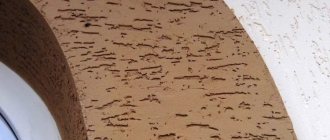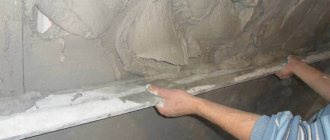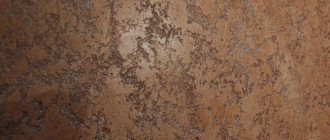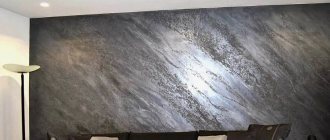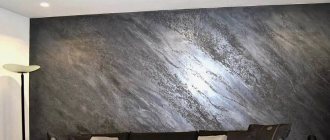Marble plaster is a universal material that is suitable for both interior and exterior work. This type of finishing allows you to obtain a coating that imitates the surface of natural stone. There are many varieties of material, differing in texture and color. If you wish, you can prepare your own plaster mixture and finish the walls.
What is this
Marbled plaster is a special type of decorative coating that is often used to decorate houses and apartments in a classic style. When purchasing a mixture, you should keep in mind that sellers may call it Venetian. This decorative coating, despite its popular name, was invented not in Venice, but in Ancient Rome.
In those days, the exquisite design of a home became a sign of the owner’s good taste and wealth. However, processing natural stone was too expensive and required a lot of effort, so clay was the main finishing material. They began to add marble dust and slaked lime to it. The result was an elastic material that could be used to decorate both vertical and horizontal surfaces.
After the fall of Ancient Rome, this finishing method briefly lost its popularity. They remembered him in Venice during the Renaissance. The material began to be used to imitate marble slabs, because... it was almost unaffected by changes in humidity. Its spread was facilitated by ease of application, relatively low price and availability.
If the application technology was followed, the coating resembled natural marble. To enhance the decorative effect and protect against environmental factors, the surface was covered with wax and thoroughly polished. Later, various natural dyes began to be introduced into the mixture. This expanded the scope of application of the material.
Correctly applied classic marbled plaster has a unique pattern. In addition, thanks to modern dyes, this material is actively used to imitate jasper, jade and many other natural minerals. There are several finishing options. If necessary, a rough surface can be obtained.
When using Venetian to create an imitation of polished natural stone, the coating results in a glossy finish. It reflects light and visually expands the room. Some craftsmen use this type of plaster to create complex images.
Features of the material
It is not difficult to guess what the filler in marble plaster is. Yes, this is indeed dust and crumbs formed during the processing of marble at mining and processing enterprises of various rocks. The finishing mixture also includes other components, including binders. These can be acrylic-based emulsions, polymer resins, lime, coloring pigments and other additives. Some of them are responsible for giving color to the finishing material, and some are responsible for ensuring that the plaster hardens quickly and adheres well to the surface. There are also those that protect the already applied material from the development of mold, mildew and other “inhabitants” on it - for example, these are antiseptics, as well as water-repellent preparations.
Façade finishing with marble plaster
Colored marble chips for decorative plaster
The history of marble plaster began in ancient times; the material was widely used in Ancient Egypt and Ancient Rome and turned out to be so durable, reliable, high-quality and beautiful that it is used for wall decoration to this day. Only now a person can easily choose the color, texture, quality of the material and exactly the type that will satisfy all his requirements.
On a note! One of the first manufacturers of such plaster on the building materials market was. Therefore, this type of finishing is often called by the name of the company. Thus, marble plaster and bayramix are one and the same.
“Bayramix”, marble plaster photo
Marble chips as a filler have their own characteristics. Firstly, it looks quite stylish and beautiful - the texture of the wall becomes rough. Secondly, the crumb has different adhesion to various substances. Thirdly, this is a fairly durable material for wall decoration.
Marble chips
Coloring the crumbs allows you to make the facade exclusive
On a note! Only marble chips are not always used as a filler for marble plaster. Often the mixture may include granite chips. This type of plaster is called granite-marble plaster.
Marble plaster itself can have different colors, but they are all close to natural stone. However, in reality, the color range of this finishing material is very wide - such plaster is often tinted, which allows it to be used for finishing any surfaces, including facades.
Marble plaster on your walls is real
Types and composition of plaster mortar with marble
Since the times of Ancient Rome, the composition of the main components of marble plaster has remained virtually unchanged.
It includes:
- stone chips;
- dye;
- binder.
The ratio between these components also remained almost unchanged. Additionally, various synthetic substances are introduced into the material, giving the desired color and improving the performance characteristics of the finished coating.
Some modern Venetian plaster formulations still use slaked lime. This substance is especially common in environmentally friendly versions of the material. Acrylic and other synthetic additives are often used as a binding component.
The composition of the Venetian includes crumbs of such natural stones as:
- quartz;
- marble;
- granite, etc.
In addition, there are mixtures that contain artificial filler. The smaller the mineral fraction, the easier the plaster is applied to the surface. Venetian with large crumbs is used to create a relief coating.
Some environmentally friendly types of plaster use plant juices, etc., to give the material color. However, most versions of the Venetian include synthetic substances, due to which the composition acquires the desired shade. More often, manufacturers use acrylic dyes.
Dry plaster mixtures are classified depending on the filler fraction and are divided into coarse-, medium- and fine-grained. According to the type of coloring, they are colored and natural.
Silicone
Already in the name lies the main material - silicone, or rather silicone resins that bind the components. Such a coating will have self-cleaning properties and will also look great even when exposed to ultraviolet rays. These compounds perfectly repel water, thanks to which it flows evenly, collecting in drops, without leaving marks on the surface.
These are ready-made mixtures that are diluted by adding a certain amount of water. The coating will be resistant to contamination, yet easy to clean and will withstand household chemicals normally.
Silicate
The most resistant material to the development of mold and mildew. The plaster, which contains “liquid glass,” tolerates different temperature conditions well and is easy to apply. It can have many colors and shades. One of the main qualities can also be called the fire resistance of the material: it does not burn, does not melt and does not support combustion, which means it is safer for finishing than paper wallpaper, for example.
In addition to compositions, decorative plasters can be classified according to aesthetic qualities. They are divided into:
- flock;
- structural;
- textured.
These are all ready-made mixtures interspersed with large or small particles. Thanks to them, you can create a variety of coatings.
DIY marble plaster mortar
If desired, you can make a dry mixture of marble decorative plaster at home, and then a solution for application to the prepared surface.
To create the composition you will need:
- cement grade M500 and higher - 1 part;
- slaked lime - 1 part;
- marble chips of the required fraction - 3 parts.
All dry ingredients should be placed in a large container and mixed thoroughly. If necessary, you can immediately add dry color to the composition. If you are preparing marble plaster for the facade, you can increase the amount of cement by 1 part. This will increase the adhesion strength of the material to the surface.
Advantages of decorating walls with marble chips
This material is not afraid of fungus and moisture. Literally, after a couple of months, it will be very strong, so much so that even with a hammer it will be very difficult to knock it down. This means that the material is completely resistant to mechanical damage. Despite the low cost of the material, it pays off with longevity of use, because it lasts for more than one century!
Such surfaces are very beautiful and original, dirt is not too noticeable on them, and they do not require any special care.
Advantages and disadvantages of finishing with marble
Marble-like decorative plaster has both advantages and disadvantages. This material has many more positive aspects. It is recommended to use it if you need to create a coating that is durable and resistant to mechanical damage.
After hardening, the plaster acquires increased hardness. The finished coating is durable and retains its attractive appearance for a long time. Because of this property, applying facade plaster with marble chips is recommended for the basement of houses located in areas with high traffic. Accidental contact with shoes will not damage the coating. In addition, this plaster is well suited for plinths, because... Any dirt can be easily washed off from its surface.
The advantages of the material also include a large selection of shades. If necessary, you can combine different colors. This creates ample opportunities for interior and exterior decoration of houses. In addition, decorative plaster with marble chips is vapor permeable. Thanks to this property, condensation does not accumulate on the base. The coating does not fade under the influence of ultraviolet radiation.
Marble plaster for exterior use is not affected by wind, rain and other atmospheric phenomena. Another advantage of the material is resistance to fungus. This coating does not darken over time, and mold colonies do not appear on it.
The disadvantages of the material primarily include complex application technology. To achieve an even finish, some skill in applying marble chip plaster is required. Therefore, people who do not have experience working with such a coating should practice on a small area of the surface.
The disadvantages of this material include its low resistance to certain types of aggressive substances, incl. to hydrochloric acid. In addition, ready-made mixtures of decorative marble plaster are expensive.
Polymer
Mineral chips are added to these plasters. Decorative plaster granite chips have low abrasion resistance, but have a magnificent appearance. Due to this, it is used for finishing walls that do not bear a functional load. Decorative granite plaster is well bonded. Granite chips adhere perfectly to the polymer and form a uniform, beautiful layer after application. Most often, acrylic is added to the polymer mixture, as it has high decorative properties and also creates a thin film, which improves the strength of the coating.
Necessary tools for exterior and interior finishing with stone chips
To apply marble plaster for interior work, as well as for facade work, you will need the following tools:
- roulette;
- ladder;
- trowels;
- containers for mixing solutions;
- spatulas;
- rollers;
- graters;
- Master OK;
- brushes;
- construction mixer, etc.
In some cases, the work process requires the presence of masking tape. In addition, you need to take care of protective clothing and a respirator.
Prices and material consumption
The material consumption is not high: only 4 - 4.5 kg per 1 square meter.
On Yandex.Market, 15 liters of granite plaster costs 2,300 rubles.
Granite facade plaster is sold in various online stores and construction stores. Large construction stores always have certificates that confirm the good quality of granite plaster for exterior use. The online store sells the desired product without leaving home. It is only recommended to choose a reliable online store.
To be sure that an online resource will not deceive you, it is recommended to study reviews or listen to recommendations from those around you.
Preparing walls for working with marble plaster
Before applying marble chips, you should prepare the walls as thoroughly as possible. The base must be level. This will help avoid overuse of finishing material. First, the walls should be inspected to identify cracks and chips. They need to be cleaned and sealed with cement mortar.
If there are pockets of fat or fungal colonies on the surface, they need to be removed. Then the walls are leveled with plaster. When the surface is dry, it is thoroughly primed several times. The walls are left to dry for at least 24 hours. You can apply marble-like plaster with your own hands only when the humidity of the base does not exceed 10%.
Methods of applying the mixture
Step-by-step instructions on how to apply plaster:
It is recommended to spread the plaster with a spatula.
Granite plaster is always applied to a dry and flat surface. If the wall initially turns out to be uneven, you need to cover up the defects with putty in advance. Next, you need to apply a primer to the surface.
If you want to decorate the walls with Venetian plaster, we recommend that you first level the surfaces with a thin layer of putty. Then, after leveling, sand it with sandpaper. Rough plaster is used when laying coarse-grained mixtures.
Technology of applying mortar with marble chips
Before applying marble plaster with your own hands, you should carefully study the technological features of this process.
Applying textured coating to walls
First, prepare a solution from the dry mixture. You must strictly follow the manufacturer's recommendations. The composition begins to be applied from the bottom edge of the wall, gradually moving upward.
Application to the façade
Coarse mixtures are used for coating. Finishing should be done in the warm season. The moisture level of the base should not exceed 5%. To apply the composition, you can use either a trowel with a spatula or a pneumatic crumb thrower. To protect the decorative layer from the influence of atmospheric phenomena, it is advisable to apply varnish.
Application of decorative material indoors for wall decoration
To create a coating, you need to take a little solution onto a trowel and, using a spatula, with slight pressure, distribute the composition over the surface in a thin layer. The trowel is held at an angle of 15°. The slope should be gradually reduced until all the accumulated mortar is applied to the wall. The rest of the mixture must be dumped back into the container with the mass.
After 3-4 cycles, the trowel should be cleaned with a damp soft cloth. 15 minutes after applying the layer, the plaster is grouted and defects are smoothed out. To improve the performance characteristics of the coating, it is additionally coated with varnish.
This is especially important if the marble mortar is white or beige. Applying an additional water-repellent layer will make further maintenance of the coating easier.
Creating a stone pattern in the interior
Using plaster of different colors. you can create complex designs. To do this, first draw the selected ornament on the surface with a pencil. Then painters are glued to the parts that do not need to be treated with finishing material of the desired color. After this, the free areas are finished with plaster. Before the mixture dries, the masking tape is removed along with excess decorative material. In this way, all fragments of the future drawing are gradually filled with plaster of the desired color.
The main mistakes when preparing and applying decorative plaster from marble chips
Often the result is unsatisfactory due to poor preparation of the base. It is extremely important to eliminate pockets of fungus, old peeling plaster and level it. If this is not done, the finished coating will look untidy and will quickly peel off. When preparing the wall, moisture-resistant compounds should be used so that further contact with the decorative layers does not lead to their softening.
You should not put too much plaster on the trowel, because... in this case, the finished coating may turn out rough. It is not recommended to ignore the procedure for cleaning the instrument, otherwise dried pieces of the solution will damage the texture. You cannot use a spatula on dry areas, because... this will cause scratches.
Types of pebble mixtures
There are no particular differences between the compositions; it all comes down to the fraction, the crumbs used and the binder. We will look at the line of the most popular brand, which produces similar products and has a lot of positive reviews. This is Ceresit plaster. It provides the following types of mixtures for decorative finishing:
- CeresitCT 60 – acrylic based. The fraction of pebbles is 1.5 and 2.5 mm. Composition consumption: for a fine fraction 2.7 kg/m2, for a large fraction 4 kg/m2. The approximate price for a 25 kg bag is from 1.7 to 2.3 thousand rubles.
- CeresitCT 63. Binder – acrylic. Used to form bark beetle on the wall. Filler fraction 2 and 3 mm. With a pebble size of 2 mm, the composition will be consumed at 2.7 kg/m2, and with 3 – 3.7 kg/m2. For a 25 kg bag you need to pay from 1.5 to 2.2 thousand rubles.
- CeresitCT 64. Acrylic, used to create bark beetle. Pebbles with a size of 1.5 and 2 mm. With a fraction of 1.5 mm, the composition will be consumed at 2.3 kg/m2, and with a particle size of 2 mm - 2.7 kg/m2. The price for a 25 kg package is from 1.6 to 2.1 thousand rubles.
- Ceresit TsT 72. Silicate plaster, has increased ductility. The stones in the composition have a grain size of 1.5 mm and 2.5 kg/m2. With a size of 1.5 mm, the material is consumed at 2.3 kg/m2, and with a grain size of 2.5 mm, 4 kg per 1 m2 will be required. The price is high - from 3.4 to 4.2 thousand rubles.
- CeresitCT 73. Silicate-based composition. Application is not limited to internal or external work, the products are universal. Pebbles measuring 1.2 mm and 2 kg/m2. With a grain size of 1.2 mm, 3 kg of mixture per 1 m2 will be required, and with a grain size of 2 mm – 2.6 kg/m2. Price for 25 kg – 3.7–4.2 thousand rubles.
- CeresitCT 77. Acrylic-based mixture. Wide grain size: 1.2; 1.6; 2 and 2.5 mm. So, in increasing grain size, the consumption will be equal to three, four, four and a half and five kg/m2. The price ranges from 2.8 to 3.6 thousand rubles. Acrylic pebble plaster has the following features: it is not afraid of moisture, as it is hygroscopic.
- CeresitCT 137. Base – mineral. Fraction 1 mm and 2.5 mm. Consumption 2 and 3 kg/m2 respectively. The price is low - 850–1.4 thousand rubles.
- CeresitCT 174. Silicate-acrylic base. Fraction 1.4 and 2 mm. Consumption is 2.5 and 3.6 kg/m2, respectively. Price for 25 kg – 2.4–2.8 thousand rubles.
- CeresitCT 175. Combined pebble plaster, based on acrylic and silicate. It allows you to create any texture on the surface. Fraction one – 2 mm. In this case, the consumption will be equal to 2.7 kg/m2. For 25 kg you will have to pay from 2.4 to 2.7 thousand rubles.
Pebble plaster goes on sale in dry and ready-made form. The cost of ready-made solutions is slightly higher.
Surface preparation
1. Bayramix marble plasters are applied to a surface previously primed with Bayramix Astar Covering primer, which should be:
2. Metal surfaces must be cleaned of traces of metal corrosion and coated with alkyd or epoxy compounds of the appropriate color tone. 3. When preparing surfaces coated with “old” paints of unknown chemical composition, using a putty material containing drying oil, treating the application area with a solution of copper sulfate, it is necessary, in order to avoid color bleeding, to cover the surface with an insulating agent - alkyd compounds (PF - 115). 4. In order to prevent areas of surface modifications from appearing on the surface of the applied Bayramix (sealing electrical wiring, sealing surface defects, sealing pipes or utilities, modified joints of plasterboard sheets, etc.), it is recommended to bring the wall surface to a uniform surface by treating the surface with putty or isolant - alkyd compounds (PF-115). For example: ready-made Bayramix finishing putty or dry putty “Finish”. 5. Application of Bayramix Astar Covering primer before applying Bayramix marble plaster is a necessary and mandatory technological process. The surface after Astar primer should be uniform in color without any unpainting and well dried. Drying of Astar universal soil at a temperature of about 20o C and a relative air humidity of 60-70% for at least 24 hours. 6. It is recommended that Astar universal primer be tinted to match the color of the selected Bayramix decorative material (if the latter has a specifically defined color scheme).
Restrictions
Recommended set of tools and accessories1.
Metal grater made of stainless steel. 2. Metal trowel. 3. A bath with a container designed for stirring 25 kg of material. 4. Flat brush with a long handle. 5. Protective cotton gloves. 6. Electric drill (perforator) with a metal stirrer. 7. Electrical extension cord. 8. Electric soffit with tripod. 9. Masking tape (paper). 10. Stepladder. 11. Special narrow metal grater (for working in hard-to-reach places). 12. Measuring tape (3 m, 5 m) 13. Polyethylene film.
Preparation for applying plaster 1. Pour the contents of the bucket into the bath, add approximately 1-1.5 liters of water (mandatory process) per 20/25 kg of material and mix thoroughly with a mixer (at least 15 minutes, at low speed). Thorough mixing should be carried out periodically until the material in the bath is completely used (make sure the water is clean) 2. Keep the buckets closed and open for use. 3. Any additives to the material are prohibited.
Application of material 1. Apply the material after completion of all construction, installation and dust-forming work, as well as defining clear structural boundaries of the finish (border of the top of the finish, border of the bottom of the finish, border along the width of the finish) in sufficient lighting (daylight, electric). Lighting should be as close as possible to the standard lighting of the room. 2. Make sure that during the process of applying the material the heating elements built into the wall surface are turned off (the latter can be turned on after the material has completely dried. 3. Applying the material requires certain professional skills from the performer - this is the ability to:
4. Apply the material to the surface using a stainless steel float from bottom to top, applying the required amount of material to the working surface of the float using a metal trowel. 5. During the finishing process, the working surface of the working tool (metal grater) must be constantly cleaned of adhering crumbs in clean water. 6. Apply the material in an even layer to the surface with the minimum possible thickness (1.5-2 crumbs, regardless of the crumb fraction), avoiding unpainted surfaces. 7. Grouting (smoothing/adjustment) of the material should be carried out no later than 15-30 minutes after its application to the surface, depending on air humidity, using a clean, damp metal float made of stainless steel without excess. effort. 8. Provide a temperature regime of at least +5°C during complete polymerization of the material (from 24 to 48 hours)
Special instructions 1. Possible coating defects:
2. When preparing facades for finishing with Bayramix marble plasters, carefully monitor the correct choice of preparatory materials (plaster, putty and other compositions must meet the requirements for facades). 3. Before starting work on finishing the facades, check the reliability of the storm and drainage engineering systems of the facade. If, as a result of a technical inspection of the facade, technical malfunctions or the absence of such systems are discovered, they must be eliminated without fail. Finishing the facade with Bayramix with faulty stormwater systems is not acceptable. 4. Applying Bayramix marble plaster in one layer is considered ideal. 5. When finishing wall surfaces with areas that are difficult to reach for finishing, it is recommended to introduce decorative inserts from the same material, but in a darker color.
Source
